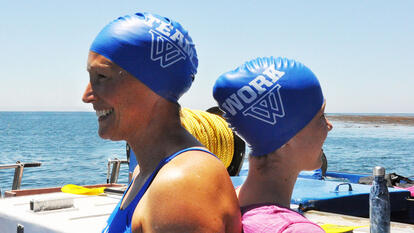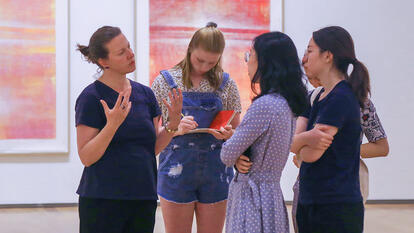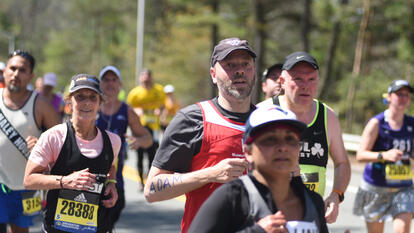
At the Whitin Observatory, Astronomy Is for Everybody
Many students interested in astronomy have to wait until graduate school to operate research-quality telescopes. But at Wellesley, all students can get a license to use the specialized equipment in Whitin Observatory.
“We have an unusually fine facility for a college of our size,” says Kim McLeod, Louise Sherwood McDowell and Sarah Frances Whiting Professor of Astrophysics and director of the observatory.
Hands-on pedagogy has been part of the mission of what is now the Department of Physics and Astronomy since the opening of the observatory in 1901. Faculty members encourage all students to spend time in it outside of class time, working toward getting licensed to use the two historic telescopes. Any Wellesley student—regardless of major, and regardless of whether they’ve taken an astronomy course—is welcome to earn the licensure. (Licensed students get a glow-in-the-dark sweatshirt and become eligible for a paying job as a night assistant, operating the telescope for introductory astronomy classes.)
The observatory “is an incredible space,” says Jonathan Kemp, physics and astronomy instrument technician. “The students really own it and live in it—to a healthy degree.”
The PlaneWave telescope, used for astrophysics research, is also a conduit for community building. When she was learning how to use it, astrophysics and political science double major Treya Pember ’25 recalls that her more experienced peers never rushed her or made her feel she was making too many mistakes. She says astronomy students have a shared awareness that “none of us are good at everything, and therefore, I think we do a really good job of supporting each other when one of us succeeds.”
Nora Hoch ’22, an astrophysics major who recently served as a postbaccalaureate assistant in the physics and astronomy department, attributes this attitude to the upperclass students’ love of astronomy and of the observatory. “They were happy to spend a Friday night with you hanging out in the telescope, and listening to music,” says Hoch. “It made this really hard subject feel really approachable.”
It’s built into the fabric of our department that astronomy is for everybody.
Kim McLeod, Louise Sherwood McDowell and Sarah Frances Whiting Professor of Astrophysics
Not only is the environment inviting, but the research equipment is accessible as well: Any student from any major can become licensed to operate the PlaneWave after taking ASTR 107: Exploring the Cosmos and ASTR 206: Astronomical Techniques.
When she came to Wellesley, McLeod conducted research that required her to visit large telescopes in South America and Hawai‘i, and she could only involve one or two Wellesley students at a time in the work. In 2010, she switched her focus to a topic she could study using the Whitin Observatory equipment, allowing her to give as many Wellesley students as possible hands-on research experience. “My students are helping me discover exoplanets around other stars right here in sea level, light-polluted Massachusetts,” she says.
The passing on of knowledge and the history of the observatory is a living aspect of the physics and astronomy department. The observatory maintains the stories of several trailbrazing alums and faculty, such as Annie Jump Cannon, class of 1884, Andrea Kundsin Dupree ’60, Martha P. Haynes ’73, Pamela Melroy ’83, Alceste Bonanos ’00, Rebekah Dawson ’09, Kathryn Neugent ’10, and Sarah Frances Whiting, the College’s first professor of physics. It also features many posters of past and present students’ work throughout its hallways. “It’s a constant reminder that there are a lot of people who have walked those halls and had similar experiences,” says Pember. “It is a small community, but it is very accomplished, and inspiring.”
Kemp says he loves when alums come back to talk about working in the field, especially those who didn’t major in astronomy or astrophysics. Molly Wasser ’09, for example, was a cinema and media studies major who, according to McLeod, “took an astronomy course and caught that fire!” Wasser became an astronomy minor, and she is now the digital media lead of the solar system exploration division at the NASA Goddard Space Flight Center. “Those stories are great to share with students because they show the realm of possibility where there is opportunity,” says Kemp.
Whitin Observatory is also open to non-majors through A.S.T.R.O. (Astronomy Students Toward Recreational Observing), Wellesley’s active and large astronomy club, which is entirely student-run. The club regularly hosts public nights at the observatory, when the telescopes are open to all Wellesley students, faculty, staff, and their families and friends, plus residents of the town of Wellesley. (The next public night will be Friday, September 22, from 8 to 10 p.m. Visit the observatory events page for additional public night dates later in the fall.)
“It’s built into the fabric of our department that astronomy is for everybody,” says McLeod. “Every student who takes our introductory courses comes up to use the telescopes—hundreds of students per year.” She points out that for many Wellesley students, a course in the physics and astronomy department might be the last science class they ever take. “I’m grateful to be able to help students understand their place in the universe and take the night sky with them,” she says.
“It’s equally important for those who might not ever aspire to have a career in science, to still have the exposure to the observatory and astronomy,” says Kemp. “I think when people look through a telescope, sometimes especially for the first time, that response can be very visceral and very connecting.”
Hoch and Pember encourage everyone to visit the observatory at least once in their time at Wellesley. “I’ve seen Saturn dozens and dozens of times, and it makes me fall in love every single time I see it. It’s awe-inspiring,” says Pember. “It can definitely be a good reminder that there are things that are bigger than Wellesley.”



